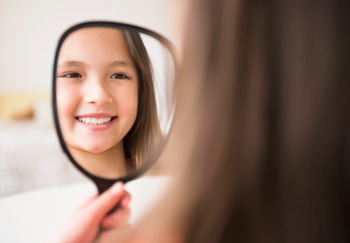This article also appeared in the May 2016 issue of Cville Family magazine.
 From airbrushed photos of fashion models to unnaturally muscular action figures, children and teens are constantly exposed to unrealistic images of what their bodies should look like.
From airbrushed photos of fashion models to unnaturally muscular action figures, children and teens are constantly exposed to unrealistic images of what their bodies should look like.
As a result, children as young as 5 and 6 are beginning to develop body image issues, according to Jaclyn A. Shepard, PsyD, a pediatric psychologist with the UVA Behavioral Medicine Center.
“In girls, we see complaints of feeling or looking fat while boys are concerned they’re not muscular enough,” she says.
Problems with poor body image peak in adolescence, when 40 to 60 percent of normal weight teenage girls view themselves as too heavy and half of teens exercise to improve their body shape or lose weight, according to the U.S. Centers for Disease Control and Prevention.
Poor body image can cause low self-esteem in children and teens, which may lead to eating disorders and depression in adulthood.
Promoting a Healthy Body Image
Shepard offers the following tips to help children and teens develop a healthy body image:
Fun for Girls
Concerned your daughter is developing a negative body image? Go Girls! is a dance-based fitness program designed to be fun while helping girls (ages 7 to 21) build self-esteem. Learn more about Go Girls!
- Model self-confidence and acceptance of your own body. Avoid negative statements about your own weight, shape or size. “It’s not intentional on the parent’s part,” Shepard says. “They’re just so used to having these reactions. But kids do pick up on that.”
- Model healthy lifestyle choices. “There’s an increase in younger children engaging in dieting behaviors or feeling dissatisfied with their own bodies because they see their parents dieting,” Shepard says. “Focus on feeling healthy rather than on appearance.”
- Avoid negative comments about other people’s bodies. Don’t use stereotypes, prejudices and words like “ugly” and “fat.” Instead, help children understand there is not one “ideal” body shape.
- Praise your child’s accomplishments, values and talents. This helps children develop positive self-esteem that’s based on who they are as people instead of their body shape or weight.
- Help children and teens understand that changes in their bodies are normal as they grow. “It’s important that teens know that some weight gain and body changes are natural parts of development in puberty,” Shepard says. Your child’s pediatrician is a good resource for helping your child understand normal development.
Shepard also encourages parents to look out for warning signs that their child is developing an unhealthy body image:
- Watch for critical or negative statements about their bodies.
- Frequent comments about their peers’ weight or bodies.
- Changes in eating behaviors or dieting.
- Increased self-consciousness around peers or increased social isolation.

